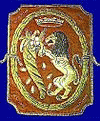Sezze
 |
The area has been known for its fine climate since Roman times: warm and dry in summer, cool in winter.
According to a legend, the city was founded by the mythical hero Hercules, after his victory over the Lestrigones, a population of giant cannibals living in southern Lazio. The town coat of arms features the white Nemean lion which Hercules slew in the first labor.
The historical Setia appeared around the 5th century BC as the Volscan settlement member of the Latin League. It became a Roman colony in 382 BC, and flourished because of its strategic and commercial position near the "pedemontana" way and the Appian Way, the road that connected Rome to southern Italy.
During the Civil War between Gaius Marius and Sulla, Setia supported the former and was later punished by the victorious Sulla (82 BC). In the Imperial period Setia was famous for its villas, and its wines were praised by Martial, Juvenal and Cicero.
According to Plutarch, Roman dictator Julius Caesar had plans to drain the wetlands around the city to create new farmland however he was assassinated before these plans could come to fruition. While not directly stated, it could be assumed this land would be cultivating grapes for the cities wine production.
In the early Middle Ages the city had a troubled life due to its location near the main road of communication. But in 956 it was freed from the Papal authority and organized itself as a commune with laws of its own. Later, several popes sojourned in Sezze, including Gregory VII (1073), Paschal II (1116) and Lucius III (1182).
The semi-autonomous status lasted until the city, after decades of skirmishes and wars with neighboring Sermoneta and Priverno, was conquered by the troops of the Caetani family in 1381. After 12 years the Setini revolted and exterminated the occupiers and, once free, they returned under the protection of the Pope.
In 1656, after suffering the ravages of plague, and raids from Spanish and Austrian troops, the population was reduced by half.
In 1690 one of the first academies in Italy, the scientific-literary Academy of the "Abbozzati", was founded in Sezze.
Map - Sezze
Map
Country - Italy
 |
 |
| Flag of Italy | |
Italy was the native place of many civilizations such as the Italic peoples and the Etruscans, while due to its central geographic location in Southern Europe and the Mediterranean, the country has also historically been home to myriad peoples and cultures, who immigrated to the peninsula throughout history. The Latins, native of central Italy, formed the Roman Kingdom in the 8th century BC, which eventually became a republic with a government of the Senate and the People. The Roman Republic initially conquered and assimilated its neighbours on the Italian peninsula, eventually expanding and conquering a large part of Europe, North Africa and Western Asia. By the first century BC, the Roman Empire emerged as the dominant power in the Mediterranean Basin and became a leading cultural, political and religious centre, inaugurating the Pax Romana, a period of more than 200 years during which Italy's law, technology, economy, art, and literature developed.
Currency / Language
| ISO | Currency | Symbol | Significant figures |
|---|---|---|---|
| EUR | Euro | € | 2 |
| ISO | Language |
|---|---|
| CA | Catalan language |
| CO | Corsican language |
| FR | French language |
| DE | German language |
| IT | Italian language |
| SC | Sardinian language |
| SL | Slovene language |















